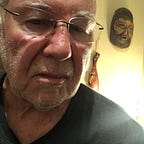To Our Health
Let’s talk about the most basic element of holistic healing
In my last post I was writing about my visit with the cardiologist. When it comes down to it, doctors are people I know who have spent a lot of time learning interventions. That’s the focus of allopathy. A cardiologist is focused on intervening in the many problems a heart can have. This focused intervention in a process can block out the bigger picture, of balancing energy.
Cancer, for example, is a process we want to avoid if we can, knowing that sometimes it shows up in the body, but the question is, what causes it to show up? This presumes a cause to effect process because without it there’s no predictability. Intervention depends on predictability. But is cancer predictable? Maybe there is a branch of medicine where instead of intervening in a process, we instead erase everything except the body, and tune it to high quality emotional frequency? This is the other branch of medicine, which is ignored because it’s free.
I love my heart in an unabstracted way. I try to make friends with it without being obsequious. There are enumerated qualities of the heart, but enumeration is an example of how new knowledge falls first on the intellect, and only with time penetrates into the body, assuming that it has the capacity to become embodied. Does this help my lipid panel? I have no idea. I stopped thinking about my lipid panel and began thinking about the endocrine system, and how to balance the hormones. If I do that, it is not as likely that I’ll need intervention. I hope.
A friend with a dog bite said he was healing it. I saw him get bit. A German Shepherd hit him like a bullet. The next day he was sitting on the stairs, looking at it. When I asked what he was doing, he said he was healing it. I asked, “How do you do that? With your mind?”
“You pay attention to it. What else can you do?”
So, I reasoned, the key element is the quality of the attention. The thing about healing the body with the quality of the attention is that it’s not a process which can be quantified and repeated. There’s nothing to prove. This is where it gets tricky, that there’s nothing to prove. Try billing insurance for that.
It’s easy to get focused into the idea that lowering the LDL will prevent heart attacks and strokes without considering what else might result from lower LDL. My idea of course is to focus on the quality and size of the LDL rather than the particle number, and, looking at it holistically, I don’t want cancer.
Patients with low concentrations of low density lipoprotein (LDL) cholesterol, lowered as a result of taking statins, are at significantly more risk of being diagnosed as having cancer compared with patients with higher concentrations of the cholesterol, according to a meta-analysis of 23 large studies of statins (Journalof the American College of Cardiology 2007;5:409–18).
Doctors don’t really work for us anymore because we aren’t paying them. The insurance companies are paying them. The products driving profits for everybody are instruments of intervention in a process. Statins intervene in a process by which the liver regulates LDL by removing it with receptors. As I mentioned in my last piece, these receptors pick up recognizable LDL. If it’s glycated and isn’t recognized, it becomes a foreign invader, the immune system atacks it, and there’s inflammation. So is lowering the count by removing perfectly good LDL really healing anybody of anything?
All of this focuses in on the intervention into a process, and I am very impressed with the progress in allopathic medicine. Phenomenal. But the body as a whole is not necessarily responding to a series of interventions by returning to a holistic balance. The body is responding to our emotional tone, which resonates in the heart. I mentioned that there are qualities of the heart. I first heard them enumerated by Dr. Brugh Joy, who combined being an internist at UCLA with spiritual teaching. Four of these qualities are, compassion, innate harmony, the healing presence, and unconditional love. The image for innate harmony is the Egyptian motif of weighing the heart against a feather.
As in a series of dreams, each of these qualities is at its core the same. The healing presence is the sudden alteration of state when time shifts, and it’s all one thing, as with the heart in perfect balance. Compassion, not to be confused with pity, is a recognition of the other’s journey and being there with them. I don’t know of an image for unconditional love. It’s an absence of anything else but love.
